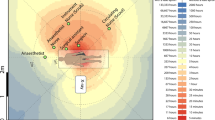Abstract
In this study, we attempted a comparative analysis of the dose and imaging difference between the deep inhalation (DI) and deep exhalation (DE) chest radiography of the same region. Healthy volunteers (n \(=\) 30; 27 men and 3 women) free of chest disease in their 20s, 30s, and 40s were selected as the subjects of this study. We employed an X-ray generator (Philips) with a built-in ion chamber and an Active Breathing Coordinator (ABC) system Version 1.02 (Elekta) with embedded software (Aktina Medical Co., USA) that produces graphs following breathing cycles. Significant differences (p \(<\) 0.05) in statistical processing were analyzed with a \(t\) test using SPSS version 18.0. The measurements of vital capacities using ABC during chest radiography resulted in overall mean air volumes of 2,220 and 1,507 ml during DI and DE, respectively, which yielded a vital capacity of 3,727 ml. The radiation doses of 30 volunteers during chest radiography were 8.50 \(\pm \) 1.85 \(\upmu \)Gym\(^{2}\) and 11.29 \(\pm \) 4.71 \(\upmu \)Gym\(^{2}\) during DI and DE, respectively, thereby demonstrating a 32 % increase during DE compared to DI. The 95 % confidence interval of the difference between X-ray doses during DI and DE was 1.89–3.89 and showed a statistically significant difference (p \(=\) 0.009). It was thereby verified that images with the same degree of sensitivity could be obtained with a lower dose during DI. The Cardiothoracic ratio in the DI and DE were 43.05 \(\pm \) 3.70 and 54.53 \(\pm \) 5.48 %. The 95 % confidence interval of the difference between Cardiothoracic ratio during DI and DE was 10.14–12.66 and showed a statistically significant difference (p \(=\) 0.001). Histogram of gray values of chest image in the DI and DE were 144.67 \(\pm \) 75.50 and 125.27 \(\pm \) 75.46. Accurate chest radiography image can be obtained during DI examination than DE. Chest radiography during DI can reduce the patient’s exposure from radiation dose.







Similar content being viewed by others
References
Ahn, B.S.: A study on the scattered dose in portable chest radiography. J. Radiol. Sci. Technol. 23(2), 63–67 (2000)
Chest X-ray examination of the patient in the amount of dose recommendation guidelines, KFDA, 2008
UNSCEAR: Report, vol. I. Sources and Effects of Ionization radiation, Annex D Medical radiation exposure, UNSCEAR (2000)
ICRP: Protection of the Patient in Diagnostic Radiology, Publication 34, Annals of the ICRP 9(2/3), Pergamon Press, Oxford (1982)
ICRP: 1990 Recommendations of the International Commission on Radiological Protection. Publication 60, Annals of the ICRP, vol. 21, No.1–3, Pergamon Press, Oxford (1991)
ICRP: Radiological Protection and Safety in Medicine, Publication 73, Annals of the ICRP 9(2/3), Pergamon Press, Oxford (1996)
Kim, H.G.: Measurement of diaphragm in normal human. J. Radiol. Sci. Technol. 30(4), 335 (2007)
Bacher, K., Smeets, P., Bommarens, K., De Hauwere, A., Verstraete, K., Thierens, H.: Dose reduction in patients undergoing chest imaging: digital amorphous silico, flat-panel detector radiography versus conventional film-screen radiography and phosphor-based computer radiography. AJR 181, 923–929 (2003)
Tsapaki, V., Aldrich, J.E., Sharma, R., Staniszewska, M.A., Krisanachinda, A., Rehani, M., Hufton, A., Triantopoulou, C., Maniatis, P.N., Papailiou, J., Prokop, M.: Dose reduction in CT while maintaining diagnostic confidence: diagnostic reference levels at routine head, chest, and abdominal CT-IAEA-coordinated research project. Radiology 240(3), 828–834 (2006)
Kim, E.K.: A Study on the State of Setting Irradiation Conditions and Awareness of Dose and Quality control of Diagnostic Disital Radiography, The Graduate School of Bio-Medical Sciense, Korea University: master’s thesis, pp. 10 (2010)
Jeong, Y.T.: Human Physiology, p. 333. CHUNG-KU Publishing, Seoul (1999)
Theodore, E., Keats, P.: Atlas of Roentgenographic measurement, 2nd edn., 170 (1967)
Kim, H.G.: The findings on cardiothoracic ratio in simple chest radiography. J. Radiol. Sci. Technol. 27(4), 43–44 (2004)
Acknowledgments
This research was supported by a Kangwon National University research Grants in 2014.
Author information
Authors and Affiliations
Corresponding author
Rights and permissions
About this article
Cite this article
Jeon, MC., Han, MS., Lim, HS. et al. The analysis of doses and image at chest radiography using an Active Breathing Coordinator (ABC) system. Cluster Comput 18, 659–665 (2015). https://doi.org/10.1007/s10586-014-0410-z
Received:
Revised:
Accepted:
Published:
Issue Date:
DOI: https://doi.org/10.1007/s10586-014-0410-z




